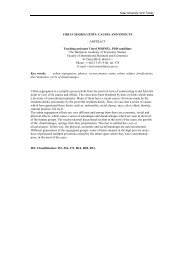Indre Jucaityte
Indre Jucaityte
Indre Jucaityte
You also want an ePaper? Increase the reach of your titles
YUMPU automatically turns print PDFs into web optimized ePapers that Google loves.
steps. However, for many consumer the perception and satisfaction is more important<br />
than price when the products are technically similar. As a contrast, marketing of senses<br />
includes feelings that consumers are experiencing. These experiences include the sensory,<br />
emotional, cognitive, behavioral and relationship dimensions. Today, in order to compete<br />
with strong brands, the feelings of consumers can not be ignored. Carefully selected<br />
emotional stimuli may help to establish consumer preferences and distinguish the brand<br />
from its competitors. It is important to understand consumers and develop positive<br />
consumers’ attitude towards the brand. As the commercial offers almost are the same, and<br />
the products and services are assimilated, sensual / emotional elements can create an<br />
unique brand. Marketing of sense is an effective tool for those, who want to improve their<br />
performance. As all buyers feelings can be managed. Brand points out how the product<br />
makes a person feel so, emotional perception of the brand awareness is becoming<br />
increasingly popular. The emotional connection between company and consumers for<br />
long-term is the only key to success in modern markets.<br />
2. BRAND VALUE AND ITS DEVELOPMENT<br />
2.1. The conceptual essence of brand value<br />
With regard to the concept of brand value, it can be spun into the definition of two<br />
elements: tangible and intangible, as well as consumer and company aspects (Vanagiene,<br />
Ramanauskiene, 2008). Value concept in the scientific literature and practical activities is<br />
is used in a variety of meanings. Kotler and Keller (2007) argue that brand value is an<br />
important intangible asset for the company providing a psychological and financial<br />
benefits. In the recent marketing literature two concepts of value are dominating – the<br />
value for the consumers (customer value) and the value for the company (equity) (Smith,<br />
Colgate, 2007). However, according to Khalifa (2004), namely the value for consumer is<br />
a prerequisite for all other values (Vaitkiene, Pilibaityte, 2008). Scientists unanimously<br />
accept and distinguish two concepts of brand value (Urbanskiene, Vaitkiene, 2006):<br />
2<br />
• brand value with regard to the customer;<br />
• brand value with regard to marketing, finance (for the company).<br />
Despite the growing interest in creating the value for the consumer, it is quite difficult to<br />
find an unified concept of brand value for the consumer in the scientific literature.<br />
According to Khalifa (2004), the lack of consensus determines, that consumer perception<br />
of brand value can be called constantly expanding and dynamic concept. In other words,<br />
the brand value for the consumer can be understood as a relationship between the<br />
consumers’ benefits and the common costs (Woodruff, 1997).




